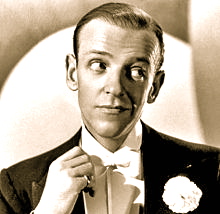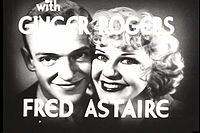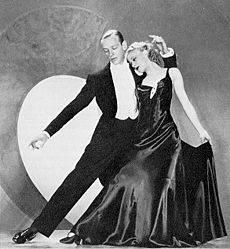Fred Astaire

Fred Astaire And Rita Hayworth — “I’m Old Fashioned”
The famous dance under moonlight from their last pairing on screen: “You Were Never Lovelier” in 1942. Jerome Kern wrote the classic song “I’m Old Fashioned”, with a lyric by Johnny Mercer, for this film. Wiki reports: “Although Hayworth had a fine voice, Harry Cohn insisted on her singing being dubbed throughout by Nan Wynn…..Dance director was Val Raset, the one and only time he collaborated with Astaire, and his choreographic input into the film is unclear”
Fred Astaire, in his autobiography “Steps In Time” wrote: “My first meeting with Rita was in a rehearsal hall at Columbia Studios. It was upstairs in one of the buildings and, as I recall, the stairway led directly into the large rehearsal room. As I came up the last few steps I gave a hurried glance around, expecting to see Rita, as I had been told she would be there. I didn’t see her and asked one of the assistants, “Isn’t Miss Hayworth going to be here this morning?” he pointed to a remote corner of the room, “Why, yes–she’s been here for some time, there she was. Oh yes–a beautiful sight.”
 In You’ll Never Get Rich (1941)
In You’ll Never Get Rich (1941)
Gene Kelly, another major innovator in filmed dance, said that “the history of dance on film begins with Astaire”. Beyond film and television, many classical dancers and choreographers, Rudolf Nureyev, Sammy Davis, Jr., Michael Jackson, Gregory Hines,Mikhail Baryshnikov, George Balanchine and Jerome Robbins among them, also acknowledged his importance and influence.Fred Astaire (born Frederick Austerlitz; May 10, 1899 – June 22, 1987) was an American film and Broadway stage dancer, choreographer, singer and actor. His stage and subsequent film career spanned a total of 76 years, during which he made 31 musical films. He was named the fifth Greatest Male Star of All Time by the American Film Institute. He is particularly associated with Ginger Rogers, with whom he made ten films.
1917–1933: Stage career in Broadway and London
 Fred and Adele Astaire in 1921
Fred and Adele Astaire in 1921
They followed up with several more shows, and of their work in The Passing Show of 1918 Heywood Broun wrote: “In an evening in which there was an abundance of good dancing, Fred Astaire stood out … He and his partner, Adele Astaire, made the show pause early in the evening with a beautiful loose-limbed dance.“
By this time, Astaire’s dancing skill was beginning to outshine his sister’s, though she still set the tone of their act and her sparkle and humor drew much of the attention, due in part to Fred’s careful preparation and strong supporting choreography.
During the 1920s, Fred and Adele appeared on Broadway and on the London stage in shows such as George and Ira Gershwin‘s Lady Be Good (1924) and Funny Face (1927), and later in The Band Wagon (1931), winning popular acclaim with the theater crowd on both sides of the Atlantic. By then, Astaire’s tap dancing was recognized as among the best, as Robert Benchley wrote in 1930, “I don’t think that I will plunge the nation into war by stating that Fred is the greatest tap-dancer in the world.”
After the close of Funny Face, the Astaires went to Hollywood for a screen test (now lost) at Paramount Pictures, but were not considered suitable for films.
They split in 1932 when Adele married her first husband, Lord Charles Arthur Francis Cavendish, a son of the Duke of Devonshire. Fred Astaire went on to achieve success on his own on Broadway and in London with Gay Divorce, while considering offers from Hollywood. The end of the partnership was traumatic for Astaire, but stimulated him to expand his range. Free of the brother-sister constraints of the former pairing and with a new partner (Claire Luce), he created a romantic partnered dance to Cole Porter‘s “Night and Day“, which had been written for Gay Divorce. Luce stated that she had to encourage him to take a more romantic approach: “Come on, Fred, I’m not your sister, you know.” The success of the stage play was credited to this number, and when recreated in the film version of the play The Gay Divorcee (1934), it ushered in a new era in filmed dance. Recently, film footage taken by Fred Stone of Astaire performing in Gay Divorce with Luce’s successor, Dorothy Stone, in New York in 1933 was uncovered by dancer and historian Betsy Baytos and now represents the earliest known performance footage of Astaire.
1933–1939: Astaire and Rogers at RKO
 The announcement of the Astaire–Rogers screen partnership—from the trailer to Flying Down to Rio. This is the only time Rogers took billing over Astaire.
The announcement of the Astaire–Rogers screen partnership—from the trailer to Flying Down to Rio. This is the only time Rogers took billing over Astaire.
According to Hollywood folklore, a screen test report on Astaire for RKO Radio Pictures, now lost along with the test, is reported to have read: “Can’t sing. Can’t act. Balding. Can dance a little.” The producer of the Astaire-Rogers pictures, Pandro S. Berman, claimed he had never heard the story in the 1930s and that it only emerged years later. Astaire later insisted that the report had actually read: “Can’t act. Slightly bald. Also dances.” In any case, the test was clearly disappointing, and David O. Selznick, who had signed Astaire to RKO and commissioned the test, stated in a memo, “I am uncertain about the man, but I feel, in spite of his enormous ears and bad chin line, that his charm is so tremendous that it comes through even on this wretched test.” However, this did not affect RKO’s plans for Astaire, first lending him for a few days to MGM in 1933 for his Hollywood debut, where he appeared as himself dancing with Joan Crawford in the successful musical film Dancing Lady.
On his return to RKO, he got fifth billing after fourth billed Ginger Rogers in the 1933 Dolores del Río vehicle Flying Down to Rio. In a review, Variety magazine attributed its massive success to Astaire’s presence: “The main point of Flying Down to Rio is the screen promise of Fred Astaire … He’s assuredly a bet after this one, for he’s distinctly likable on the screen, the mike is kind to his voice and as a dancer he remains in a class by himself. The latter observation will be no news to the profession, which has long admitted that Astaire starts dancing where the others stop hoofing.”
Having already been linked to his sister Adele on stage, Astaire was initially very reluctant to become part of another dance team. He wrote his agent, “I don’t mind making another picture with her, but as for this ‘team’ idea, it’s ‘out!’ I’ve just managed to live down one partnership and I don’t want to be bothered with any more.” He was persuaded by the obvious public appeal of the Astaire-Rogers pairing. The partnership, and the choreography of Astaire and Hermes Pan, helped make dancing an important element of the Hollywood film musical. Astaire and Rogers made ten films together, including The Gay Divorcee, Roberta (1935), Top Hat (1935), Follow the Fleet(1936), Swing Time (1936), Shall We Dance (1937), and Carefree (1938). Six out of the nine Astaire-Rogers musicals became the biggest moneymakers for RKO; all of the films brought a certain prestige and artistry that all studios coveted at the time. Their partnership elevated them both to stardom; as Katharine Hepburn reportedly said, “He gives her class and she gives him sex appeal.”
Astaire received a percentage of the films’ profits, something extremely rare in actors’ contracts at that time; and complete autonomy over how the dances would be presented, allowing him to revolutionize dance on film.
Astaire is credited with two important innovations in early film musicals. First, he insisted that the (almost stationary) camera film a dance routine in a single shot, if possible, while holding the dancers in full view at all times. Astaire famously quipped: “Either the camera will dance, or I will.” Astaire maintained this policy from The Gay Divorcee (1934) onwards (until overruled by Francis Ford Coppola, who directed Finian’s Rainbow (1968), Astaire’s last film musical). Astaire’s style of dance sequences thus contrasted with the Busby Berkeley musicals, which were known for dance sequences filled with extravagant aerial shots, quick takes, and zooms on certain areas of the body, such as the arms or legs. Second, Astaire was adamant that all song and dance routines be seamlessly integrated into the plotlines of the film. Instead of using dance as spectacle as Busby Berkeley did, Astaire used it to move the plot along. Typically, an Astaire picture would include a solo performance by Astaire—which he termed his “sock solo”—a partnered comedy dance routine, and a partnered romantic dance routine.
 An RKO publicity still of Astaire and Rogers dancing to “Smoke Gets in Your Eyes” in Roberta (1935)
An RKO publicity still of Astaire and Rogers dancing to “Smoke Gets in Your Eyes” in Roberta (1935)
Dance commentators Arlene Croce, Hannah Hyam and John Mueller consider Rogers to have been Astaire’s greatest dance partner, a view sha by Hermes Pan and Stanley Donen. Film critic Pauline Kael adopts a more neutral stance, while Time magazine film critic Richard Schickel writes “The nostalgia surrounding Rogers-Astaire tends to bleach out other partners.”
Mueller sums up Rogers’s abilities as follows: “Rogers was outstanding among Astaire’s partners not because she was superior to others as a dancer, but because, as a skilled, intuitive actress, she was cagey enough to realize that acting did not stop when dancing began … the reason so many women have fantasized about dancing with Fred Astaire is that Ginger Rogers conveyed the impression that dancing with him is the most thrilling experience imaginable.” According to Astaire, “Ginger had never danced with a partner before [“Flying Down to Rio”]. She faked it an awful lot. She couldn’t tap and she couldn’t do this and that … but Ginger had style and talent and improved as she went along. She got so that after a while everyone else who danced with me looked wrong.”
For her part, Rogers described Astaire’s uncompromising standards extending to the whole production, “Sometimes he’ll think of a new line of dialogue or a new angle for the story … they never know what time of night he’ll call up and start ranting enthusiastically about a fresh idea … No loafing on the job on an Astaire picture, and no cutting corners.”
Astaire was still unwilling to have his career tied exclusively to any partnership, however. He negotiated with RKO to strike out on his own with A Damsel in Distress in 1937 with an inexperienced, non-dancing Joan Fontaine, unsuccessfully as it turned out. He returned to make two more films with Rogers, Carefree (1938) and The Story of Vernon and Irene Castle (1939). While both films earned respectable gross incomes, they both lost money due to increased production costs and Astaire left RKO. Rogers remained and went on to become the studio’s hottest property in the early forties. They were reunited in 1949 at MGM for their final outing, The Barkleys of Broadway.

